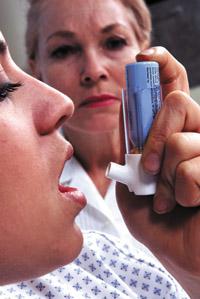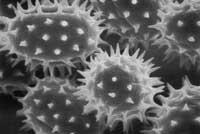Why are there allergic individuals?
2000/05/01 Arrese, Elixabete | Basaras, Miren - Mikrobiologiako Irakasle Titularra Iturria: Elhuyar aldizkaria
Nonspecific or spontaneous immunity is what we have from birth; for example, the acidity of the stomach and vagina, the lysozyme of tears, the different cells of the body (macrophages, mast cells, neutrophils, eosinophils,...). On the contrary, the specific or acquired immunity is what we acquire with life, as the word says, T and B lymphocytes, which are antibodies or immunoglobulins (expressed with the abbreviation Ig).
One of the most important characteristics of the response generated by the immune system is the existence of memory, that is, when the same microorganism enters twice in our organism, our immune response to this pathogenic or harmful microorganism is faster and more specific.
In general terms, the substance that causes damage with the introduction of the microorganism is called antigen. Therefore, the antigen itself will activate the immune mechanisms and therefore segregate the cells against itself (T lymphocytes and antibodies).
But sometimes, in this immune response there are errors that can be harmful, causing damage and diseases in the tissues. One known example is allergies.

Immune cause of allergies
Some individuals are able to produce an excessive or disproportionate immune response against non-harmful substances or antigens in the environment (called allergens). It is also said that these individuals are atypical. Most allergens are small, soluble proteins that are transported in dry particles, such as pollen or pet mites. Under normal conditions, these allergens (pollen, food, medicines, soaps...) do not induce any immune response. They normally reach the immune system in small doses, for example, the pollen allergen of grasses is only 1 µg/yr! But continued administration of this dose facilitates allergy production. Individuals should be previously sensitized. Therefore, allergic reactions are also known as hypersensitivity reactions.
When the allergen enters humans for the first time, our immune system activates and secretes antibodies against it. But sometimes these antibodies (IgE type) bind to some cells in our body, mast cells, which are sensitized or activated. No clinical symptoms occur in this first contact with the allergen. But when the same allergen enters these humans again, since mast cells are previously sensitized, the allergen binds directly to them without performing the entire previous path and mast cells release harmful substances such as histamine, proteases, leukotrienes, etc., causing clinical allergy symptoms. These allergic symptoms appear immediately after the second contact.
In general, although all allergies involve IgE and mast cells, the example, quantity and type of allergen will influence the different clinical symptoms that will appear:
- Irritation or irritation of the nasal mucosa by inhaling a small amount of allergens, such as uneven pollen or mites from pets, produces so-called allergic rhinitis, i.e. mucus, conjunctivitis, sneezing, cough, carais, etc. If the inhaled allergen reaches the lower airways, the syndrome produced will be more severe causing asthma in the bronchi and with respiratory distress.
- If the allergen enters by mouth with food (seafood, milk, egg albumin, fish, cereals,...), the intestinal mucosa will be affected. The secretion of local fluids increases and the most common symptoms are skin urticaria (redness and itching), bottoms, diarrhea, abdominal pain, etc.
Sometimes the face, lips, and eyelids increase causing the so-called angioedema.
- Some medicines (vaccines, penicillin, sulfonamides, etc.) appear intravenously. or the poison of some insects (bees, wasps), systemic anaphylaxis (word derived from the Greek; ana: against/out, phylaxis: protection), in which there is a sudden loss of blood vessel pressure and an occlusion of extreme circulation.
- When the allergen enters the inside of the dermis (insect bites or proof that a person is allergic), redness, pain, and swelling appear at the point of puncture, i.e., dermatitis.
On the other hand, it has been observed that in this development of allergic diseases also influence our genes. The latest genetic studies propose the participation in human allergy of genes from our chromosomes as 6p21.3, 11q13. Therefore, if both parents are atopic, the probability of the child being atopic is 75%. But do all allergies occur through IgE and mast cell damage? The answer is negative. For example, speaking immune, sometimes the allergy that produces the watch belt or earrings is totally different. Contact dermatitis occurs in these cases. The response to these skin reactions (against some metal ions: nickel, chromate; or against some haptenes: pentadekaketol or ivy poison) is cellular, especially T lymphocytes. In these delayed hypersensitivity reactions, T lymphocytes after first contact with the antigen are activated by releasing substances called cytokines, which activate macrophages. When there is a second contact, activated macrophages and T lymphocytes accumulate giving inflammation and dermatitis in the skin area in which this contact has occurred, eczema and peeling may appear in the skin. This is, for example, what happens when the tuberculin test is done to find out if there has been contact (Mycobacterium tuberculosis).
What are the most common allergies and allergens in our environment?
It is clear that the prevalence of allergies is high, more and more people are allergic and mostly young. This high prevalence among young people can be related to the increasing immunological decrease of them. In adults, however, there are fewer allergies.
A greater number of allergic diseases have also been observed in larger populations due to increased exposure to pollution and all allergens. Due to seasonality, in general, allergies are found throughout the year, but in spring-summer the increase is remarkable.
A study conducted in the State in recent years reveals the epidemiology of allergies. It is observed that the prevalence rate of allergies in the Basque Country is intermediate, of 15.1%. Of all the allergies that appear, the most common is allergic rhinitis and the lowest rate is angioedema.
As for the allergens present in our territory, it should be noted that the most common are pollen and dust mites, in addition to animal hairs and mites, medicines, sun and soaps.
How can the allergen be detected in the laboratory?
The diagnosis is to measure the level of immunoglobulin E. There are several serological tests for measurement (the normal level of Ig E is 5 x 10-5 mg/ml).
The most common test currently performed is the classic intradermal test. This technique involves the introduction of different allergens to the arm or neck. The test will be positive if edema appears in the injected place, with signs of flushing and inflammation. This concludes that this patient has the IgE associated with mast cells.
How can allergies be treated?
It is clear that the only thing that can be done from a preventive point of view is to avoid the allergen itself (dust, pets, meals,...). If this is impossible and we have an allergic disease, what can be done? Current therapy involves taking medicines that reduce allergy symptoms. Anaphylactic reactions are treated with bronchodilators that relax the muscle constriction of the bronchi and accelerate the heart. Antihistamines are used in allergic rhinitis and skin urticant treatment. On the other hand, in chronic allergic disease topical and systemic corticosteroids are used to prevent chronic alterations of inflammation.
Immediate future therapy is hyposensitization or immunotherapy. A controlled allergen is injected into this treatment. The allergen is given weekly and increasing doses are injected from the minimum. In this way it is possible to reduce the response of the IgE and obtain answers of the type IgG or immunoglobulins of the memory. An immunotherapy cycle can last 3 years or longer and the current results, although hopeful, do not come to cure at all, but it is possible to relieve symptoms and benefit patients.
Another option would be to block the immunoglobulin E receptor. In this way it would not be related to mast cells. To get this blocking molecule has been worked experimentally, but there is still no effective work.

Gai honi buruzko eduki gehiago
Elhuyarrek garatutako teknologia





